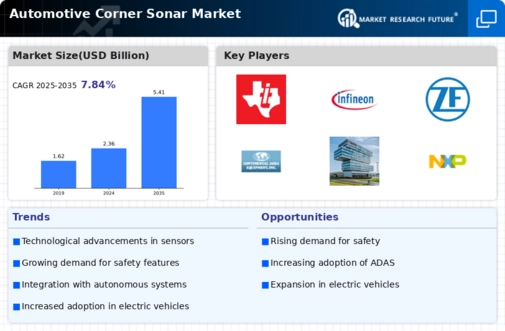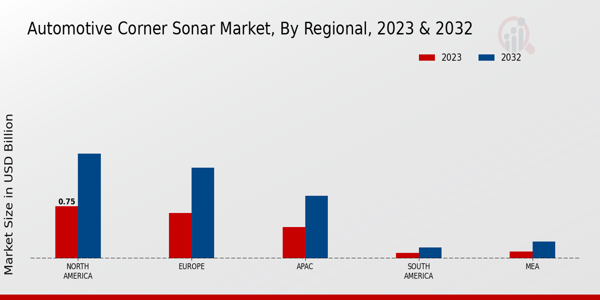Market Growth Projections
The Global Automotive Corner Sonar Market Industry is poised for substantial growth, with projections indicating a rise from 2.36 USD Billion in 2024 to 5.41 USD Billion by 2035. This growth trajectory suggests a compound annual growth rate (CAGR) of 7.84% from 2025 to 2035, reflecting increasing investments in automotive safety technologies. The expanding market is driven by factors such as technological advancements, regulatory requirements, and evolving consumer preferences for safety features. As the automotive industry continues to innovate, the corner sonar market is likely to thrive, presenting opportunities for manufacturers and stakeholders.
Rising Adoption of Electric Vehicles
The rising adoption of electric vehicles (EVs) is positively impacting the Global Automotive Corner Sonar Market Industry. As the EV market expands, manufacturers are increasingly incorporating advanced safety technologies, including corner sonar systems, to enhance the driving experience. This integration is particularly vital for EVs, which often feature unique design elements that necessitate improved obstacle detection capabilities. The growth of the EV market is expected to contribute to the overall expansion of the corner sonar market, as more consumers opt for vehicles that prioritize safety and technological innovation.
Growing Consumer Preference for Safety Features
Consumer preference for enhanced safety features is a crucial driver of the Global Automotive Corner Sonar Market Industry. As awareness of road safety increases, consumers are actively seeking vehicles equipped with advanced safety technologies, including corner sonar systems. This shift in consumer behavior is prompting manufacturers to prioritize the integration of such systems in their vehicle models. The market is expected to expand significantly, with projections indicating a growth to 5.41 USD Billion by 2035. This trend underscores the importance of safety in automotive purchasing decisions, further propelling the demand for corner sonar technology.
Technological Advancements in Sensor Technology
Technological advancements in sensor technology are significantly influencing the Global Automotive Corner Sonar Market Industry. Innovations in ultrasonic and radar sensors have led to more accurate and reliable corner sonar systems. These advancements enable vehicles to detect obstacles at various angles, enhancing safety during low-speed maneuvers. As a result, the market is projected to grow at a compound annual growth rate (CAGR) of 7.84% from 2025 to 2035. This growth is indicative of the automotive industry's commitment to integrating cutting-edge technology into vehicles, thereby improving overall driving experiences and safety.
Regulatory Push for Enhanced Vehicle Safety Standards
Regulatory bodies worldwide are increasingly mandating enhanced vehicle safety standards, which is driving the Global Automotive Corner Sonar Market Industry. Governments are implementing stricter regulations that require the incorporation of advanced safety features in new vehicles. This regulatory push is compelling manufacturers to adopt corner sonar systems as part of their safety suite. As a result, the market is likely to see substantial growth, as compliance with these regulations becomes essential for manufacturers aiming to maintain competitiveness. This trend not only enhances vehicle safety but also aligns with global efforts to reduce traffic accidents.
Increasing Demand for Advanced Driver Assistance Systems
The Global Automotive Corner Sonar Market Industry is experiencing a surge in demand for advanced driver assistance systems (ADAS), which enhance vehicle safety and convenience. As consumers become more safety-conscious, automakers are integrating corner sonar systems to assist with parking and obstacle detection. This trend is reflected in the projected market growth, with the industry expected to reach 2.36 USD Billion in 2024. The integration of corner sonar technology into ADAS not only improves vehicle functionality but also aligns with regulatory requirements for enhanced safety features, thereby driving the market forward.



















